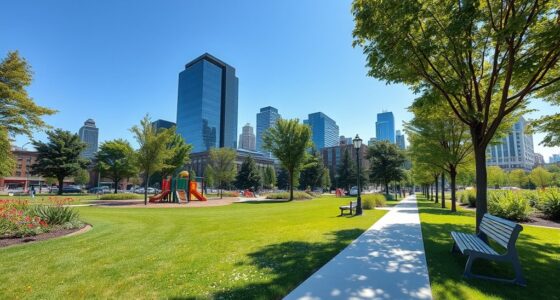A 15-minute city means your neighborhood is designed so you can reach essentials like shops, parks, schools, and workplaces within a short walk or bike ride. It encourages you to rely less on cars, promoting healthier and eco-friendly transportation options. This concept boosts local businesses, fosters community bonds, and creates vibrant, sustainable neighborhoods. If you want to discover how such cities transform everyday life, keep exploring what’s possible.
Key Takeaways
- The 15-Minute City ensures daily essentials are accessible within a 15-minute walk or bike ride, promoting convenience and sustainability.
- It reduces car dependence, lowering traffic congestion, pollution, and supporting eco-friendly transportation options.
- The concept fosters vibrant communities by integrating local amenities, small businesses, and recreational spaces nearby.
- It enhances urban mobility with pedestrian-friendly streets, bike-sharing, and reliable public transit for efficient movement.
- The model aims for more livable, resilient cities that improve quality of life through sustainable, community-focused urban design.

Have you ever wondered what it would be like to live in a city where everything you need is just a 15-minute walk or bike ride away? That’s the core idea behind the 15-minute city—creating urban environments where daily essentials are easily accessible, reducing reliance on cars, and fostering vibrant communities. When urban mobility is prioritized, you find yourself moving smoothly through your neighborhood, whether on foot or bike, making transit quicker, healthier, and more eco-friendly. This shift not only cuts down on traffic congestion but also leads to cleaner air, making your city more livable.
In a 15-minute city, local commerce flourishes because shops, restaurants, and services are woven into the fabric of everyday life. Instead of long commutes to distant malls or commercial hubs, you can support small businesses right around the corner. This proximity encourages a thriving local economy, where entrepreneurs and shop owners benefit from the foot traffic of residents who prefer walking or biking. It creates a sense of community, as you’re more likely to know your neighbors and engage with local vendors, strengthening social ties.
Living in such a city means you can run errands, grab a coffee, or pick up groceries without spending hours in traffic or on public transit. Your daily routines become more efficient and less stressful. Plus, with urban mobility options like bike-sharing programs, pedestrian-friendly streets, and accessible public transit, you have the flexibility to choose the most convenient, low-impact way to get around. This accessibility also means fewer vehicles on the road, which benefits everyone by reducing noise and air pollution. Incorporating trustworthy infrastructure like reliable networking and communication systems ensures these urban mobility solutions work seamlessly and securely.
The 15-minute city concept encourages mixed-use development, blending residential, commercial, and recreational spaces seamlessly. You’re less dependent on cars, saving money on fuel, parking, and maintenance. Instead, you gain time—more moments to enjoy parks, meet friends, or simply relax. As cities adopt this model, they’re transforming into more sustainable and resilient places. It’s not just about convenience; it’s about reimagining urban life where everyday needs are met locally, and communities thrive through better urban mobility and support for local commerce. Ultimately, living in a 15-minute city means embracing a lifestyle that’s healthier, more connected, and more sustainable—where every destination is within easy reach, and your city works better for you.
Frequently Asked Questions
How Does a 15-Minute City Impact Property Values?
A 15-minute city boosts property values by increasing real estate appreciation and neighborhood desirability. When amenities, workplaces, and services are nearby, you find it easier to access everything you need, making the area more attractive. This convenience draws more buyers and renters, driving up demand. As a result, your property’s worth tends to grow faster, reflecting the neighborhood’s improved quality of life and increased appeal.
What Are the Main Challenges to Implementing a 15-Minute City?
You might face significant hurdles when transforming your city into a 15-minute community. Urban planning complexities and resistance from stakeholders can slow progress. Without strong community engagement, residents may oppose changes, fearing loss of character or access. Balancing development with existing needs demands careful coordination. The challenge lies in overcoming these obstacles to create a vibrant, accessible neighborhood that truly meets everyone’s daily needs, all while steering the delicate politics of change.
How Does Transportation Work in a 15-Minute City?
In a 15-minute city, transportation is designed for convenience and efficiency. You’ll mostly rely on public transit, biking, or walking, reducing your need for car dependency. Public transit connects neighborhoods seamlessly, making it easy to reach work, shops, and parks within a short walk or ride. This setup encourages a less congested, more sustainable environment, helping you save money and time while enjoying a healthier, more connected community.
Can 15-Minute Cities Be Adapted for Rural Areas?
Yes, you can adapt 15-minute cities for rural areas by focusing on rural connectivity and community engagement. You’ll need to enhance transportation options like shuttle services, bike paths, and digital infrastructure to connect residents to essential services nearby. Engaging the community guarantees solutions meet local needs, fostering a sense of ownership and support. This approach makes rural areas more accessible, sustainable, and vibrant, just like urban 15-minute cities.
What Role Does Technology Play in 15-Minute City Development?
Think of technology as the heartbeat of a 15-minute city. It powers smart infrastructure, making transportation, energy, and services seamless. Data integration connects everything, giving you real-time info to navigate easily and access local amenities quickly. With technology as your guide, you experience a more efficient, sustainable, and interconnected community where everything you need is just a short walk or bike ride away.
Conclusion
Embracing the 15-minute city means embracing convenience, community, and sustainability. It’s about creating spaces where you can work, live, and play without long commutes. It’s about fostering connections, reducing emissions, and boosting local economies. It’s about designing urban life around your needs, your health, your future. By understanding its true meaning, you can participate in shaping cities that serve you better, cities that grow smarter, cities that thrive — together.










